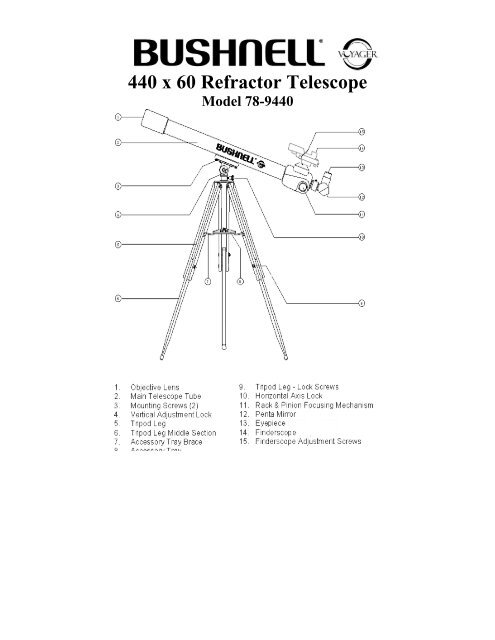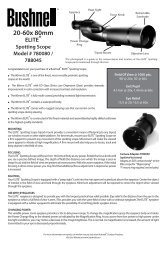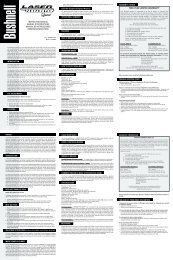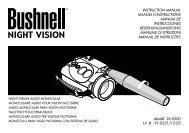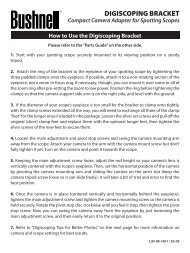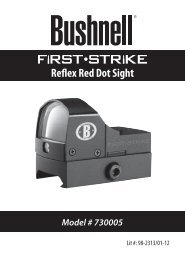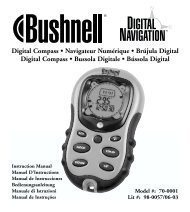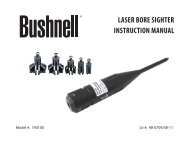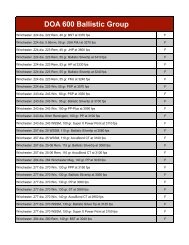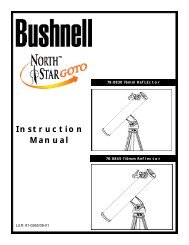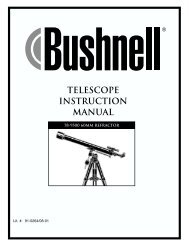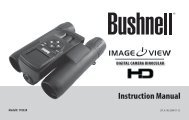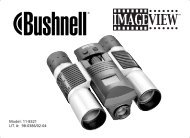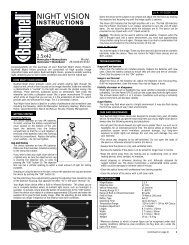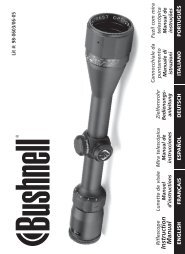440 x 60 Refractor Telescope - Bushnell
440 x 60 Refractor Telescope - Bushnell
440 x 60 Refractor Telescope - Bushnell
You also want an ePaper? Increase the reach of your titles
YUMPU automatically turns print PDFs into web optimized ePapers that Google loves.
<strong>440</strong> x <strong>60</strong> <strong>Refractor</strong> <strong>Telescope</strong><br />
Model 78-9<strong>440</strong>
STANDARD EQUIPMENT<br />
• <strong>Refractor</strong> <strong>Telescope</strong> Assembly<br />
• Exclusive Metal Easy Track® Mount<br />
• Variable Height-Aluminum Tripod<br />
• Exclusive Penta Mirror Assembly<br />
• 8mm, and 12.5mm focal length - Eyepieces.<br />
• Red Dot Finderscope<br />
• Accessory Tray<br />
• 1.5x Erecting Lens<br />
• 2.5x Barlow<br />
• Hardware Packet—(3) Tripod Bolts with Wing Nuts, (3) Short<br />
Accessory Tray Bolts with Wing Nuts, (3) Tripod Leg Lock<br />
Screws<br />
TELESCOPE ASSEMBLY<br />
1. Remove all components from the carton and identify all components. It is a good idea to lay<br />
all the parts out in front of you before assembly. READ THROUGH ASSEMBLY INSTRUCTION<br />
BEFORE YOU ASSEMBLE YOUR TELESCOPE. The only tool required in setting up your<br />
telescope is a slotted or Phillips blade screwdriver. Since your telescope is a precision<br />
optical system the parts require careful handling--particularly the telescope, eyepieces, and<br />
various accessory lenses.<br />
2. Set-Up Tripod<br />
Select one tripod leg. Loosen Tripod Leg Lock Screw (9) and extend the Tripod Leg Middle Section (6).<br />
For a moment, do not extend the leg fully...a shorter leg is less awkward to work with during set-up.<br />
Tighten the Tripod Leg lock Screw so that the Middle Section is securely in place. Repeat for the<br />
remaining two legs.<br />
3. Attach <strong>Telescope</strong> and Finderscope<br />
• Note: Before assembling tripod legs to Easy Track® Mount,<br />
make sure the Accessory Tray Braces (7) face inward.<br />
Loosen long bolts at the top of Tripod Leg (5). Position the<br />
mount over the Tripod Leg as shown (fig. 2). and secure<br />
Easy Track® Mount to Tripod Leg. Repeat on the<br />
remaining two Tripod Legs. Once you have attached all<br />
Tripod Legs to the mount, securely tighten all wing nuts in<br />
place.<br />
• Locate the pre-assembled <strong>Telescope</strong> Main Tube (2).<br />
Remove Main Tube Locking Nuts (3) from screws<br />
extending from bottom of <strong>Telescope</strong> Main Tube (2). Insert<br />
extended screws into holes in cradle of Easy Track®<br />
Mounting System. Re-fasten Main Tube Locking Nuts (3).<br />
• Remove plastic insert on bottom side of finderscope to<br />
allow battery to make connection with battery contact for<br />
power. Turn power switch on. See finderscope page.<br />
Fig. 1<br />
• Look through main telescope tube at low power and establish a well-defined stationary target.<br />
Looking through red dot finderscope, alternate tightening each adjustment wheel (at rear and left<br />
side of finderscope) until the red dot of finderscope is precisely aligned and centered on the same<br />
object being viewed in main telescope tube. See finderscope page.<br />
Fig. 2<br />
R
4. Attach Accessory Tray<br />
Locate the Accessory Tray (8). Using the accessory tray bolts, wingnuts and washers connect the<br />
Accessory Tray to the Accessory Tray Braces (7). Start with one tripod leg and attach wingnuts.<br />
Wingnuts should be positioned beneath the accessory tray. Do not tighten wingnuts until all<br />
Accessory Tray Braces are attached, as some adjustments may be required.<br />
5. Attach Eyepiece Accessories<br />
Attach accessories as suggested in Intended Use Diagram. For example insert penta mirror<br />
assembly into focusing tube, then insert desired eyepiece into penta mirror assembly.<br />
6. Remove Lens Cover from <strong>60</strong>mm Objective Lens(1).<br />
Your <strong>Bushnell</strong> Voyager <strong>Telescope</strong> is now ready to be used. To obtain the fullest<br />
enjoyment from your telescope, please refer to the additional information below.<br />
HOW TO USE YOUR NEW TELESCOPE<br />
Using the Penta Mirror Assembly:<br />
1. A Basic Description: <strong>Bushnell</strong> is proud to present<br />
the Exclusive Penta Mirror Technology. This<br />
Penta Mirror Assembly provides the benefit of a<br />
convenient 90-degree viewing angle commonly<br />
associated with diagonal mirrors. However, the<br />
Penta Mirror provides something that diagonal<br />
mirrors cannot provide--right to left correct views of<br />
the any object viewed through the telescope.<br />
Unlike traditional diagonal mirrors that provide<br />
backward images of objects seen on land and in<br />
the night sky, the Penta Mirror allows correct<br />
images to be viewed. The groundbreaking benefit<br />
of this technology is that when viewing and<br />
locating objects through the telescope, when you<br />
want to move to the left, you move it to the left<br />
intuitively instead of fumbling around the sky<br />
becoming increasingly frustrated that you can’t<br />
move the telescope the way your intuition tells you<br />
that you need to move it. Objects on land at great<br />
distances can be seen naturally (and readable) as<br />
if you were many times closer to the object.<br />
Objects in the sky appear as they appear in most<br />
star charts. For the first time ever, you will be able<br />
to see what you would expect resulting in excellent<br />
viewing satisfaction. In addition, the penta mirror<br />
has a special insert that is easily removed by<br />
backing out the eyepiece set screw and removing<br />
the insert to yield an 1.25” optical format receiver.<br />
2. How-To-Use: Just like any traditional diagonal<br />
mirror, place the eyepieces directly into the rear of<br />
the Penta Mirror Assembly then place the Penta<br />
Mirror directly into the back of the telescope<br />
focusing tube, erecting lens or Barlow lens (See<br />
Intended Configuration Diagram).<br />
Fully Correct Image Reversed Image<br />
Upside-Down Image Upside-Down & Reversed Image<br />
Insert<br />
Penta Mirror
Please find below an image depicting how to attach the red dot finderscope and an<br />
image depicting a fully-attached unit.<br />
How-To-Attach: Place Finderscope Cylindrical Groove over Cylindrical Finderscope<br />
Mount Post until it clicks into place.<br />
Plastic Insert<br />
Adjustment<br />
Wheels<br />
Aligning and Using Red Dot Finderscope<br />
Remove plastic insert on bottom side of finderscope to allow battery to make connection with<br />
battery contact for power. Turn power switch on.<br />
Look through main telescope tube at low power and establish a well-defined stationary<br />
target. Looking through red dot finderscope, alternate tightening each adjustment wheel<br />
(at rear and left side of finderscope) until the red dot of finderscope is precisely aligned<br />
and centered on the same object being viewed in main telescope tube.
Selecting an Eyepiece:<br />
1. You should always start viewing with the lowest power eyepiece, which in this case is the 12.5mm<br />
lens. Note: the base power of each eyepiece is determined by the focal length of the telescope<br />
objective lens, which for this model is 700 mm. A formula can be used to determine the power of<br />
each eyepiece: telescope OBJECTIVE lens focal length EYEPIECE focal length =<br />
MAGNIFICATION (e.g. Using the 12.5 mm lens, the calculation would look like this: 700 mm ÷<br />
12.5mm = 56x or 56 power.)<br />
2. Included with this telescope is a Barlow lens. Barlow lenses are used to double or triple the power of<br />
your telescope. Place your Barlow between the focusing tube and the penta mirror. Note: The<br />
Penta Mirror Assembly when used in conjunction with the Barlow Lens and Eyepiece as<br />
shown in the Intended Configuration Diagram will yield an effective doubling power of the<br />
magnification already achieved with the Barlow and Eyepiece configuration alone. The<br />
magnification calculation would look like this: 700 mm ÷ 12.5mm = 56 power. 56 power x 2.5=140<br />
power. 56 x 2.5 x 2=280 power. (See Intended Configuration Diagram).<br />
Focusing <strong>Telescope</strong>:<br />
1. After selecting the desired eyepiece, aim main telescope tube at a land-based target at least 200<br />
yards away (e.g. telephone pole or building). Fully extend focusing tube by turning Rack and Pinion<br />
Focusing Mechanism (11).<br />
2. While looking through selected eyepiece (in this case the 12.5 mm), slowly retract focusing tube by<br />
turning Rack and Pinion Focusing Mechanism until object comes into focus.<br />
Viewing Land-Based Objects:<br />
1. As described above, the Erecting Lens will correct the normally upside down and reversed image so<br />
that you can easily enjoy observing land-based objects through your telescope.<br />
2. Simply insert the Erecting Lens into the focusing tube of the telescope, penta mirror into erecting lens,<br />
then insert an eyepiece into the erecting lens. (See Intended Configuration Diagram).<br />
3. Repeat focusing directions as described above except that you will be looking through the Erecting<br />
Lens and eyepiece instead of just the eyepiece.<br />
Aligning Finderscope:<br />
Look through main telescope tube at low power and establish a well-defined stationary target. Looking<br />
through red dot finderscope, alternate tightening each adjustment wheel (at rear and left side of<br />
finderscope) until the red dot of finderscope is precisely aligned and centered on the same object being<br />
viewed in main telescope tube. See finderscope page.<br />
Now, objects located first with the wide field Finderscope (14) will be centered in the field of view of the<br />
main telescope.<br />
Never Look Directly At The Sun With Your <strong>Telescope</strong><br />
Permanent Damage To Your Eyes May Occur
Enjoying Your New <strong>Telescope</strong><br />
1. First determine your targeted object. Any bright object in the night sky is a good starting point. The<br />
moon is a starting point that is sure to please the budding astronomer as well as the experienced<br />
veteran. When you have developed proficiency at this level, other objects become good targets.<br />
Saturn, Mars, Jupiter, and Venus are good second steps to take.<br />
2. The first thing you need to do after assembling the telescope as planned is center the desired object<br />
in the finderscope's cross hairs. Provided you did a reasonable job aligning the finderscope, a quick<br />
look through the main telescope tube at low power should reveal the same image. With the lowest<br />
power eyepiece (the one with the largest number printed on it) you should be able to focus the same<br />
image that you saw through the finderscope. Avoid the temptation to move directly to the highest<br />
power. The low power eyepiece will give you a wider field of view, and brighter image--thus making it<br />
very easy to find your target object. At this point with a focused image in both scopes, you've passed<br />
the first obstacle. If you don't see an image after attempting to focus it in, you might consider aligning<br />
your finderscope again. Once you pass this step, you'll enjoy the time spent ensuring a good<br />
alignment. Every object you center in the finderscope will be easily found in the main telescope tube,<br />
which is important for continuing your exploration of the night sky.<br />
3. The low power eyepieces are perfect for viewing the full moon, planets, star clusters, nebulae, and<br />
even constellations. These should build your foundation. However, for more detail, try bumping up in<br />
magnification to higher power eyepieces on some of these objects. During calm and crisp nights, the<br />
light/dark separation line on the moon (called the "Terminator") is marvelous at high power. You can<br />
see mountains, ridges and craters jump out at you due to the highlights. Similarly, you can move up<br />
to higher magnifications on the planets and nebulae. Star clusters and stars are best viewed through<br />
the low power no matter what.<br />
4. The recurring astronomical theater we call the night sky is an ever-changing billboard. In other words,<br />
not the same movie plays all the time. Rather, the positions of the stars change not only hourly as<br />
they seem to rise and set, but also throughout the year. As the earth orbits the sun our perspective<br />
on the stars changes on a yearly cycle about that orbit. The reason the sky seems to move daily just<br />
as the sun and the moon "move" across our sky, is that the earth is rotating about its axis. As a result<br />
you may notice that after a few minutes or a few seconds depending on what power you are viewing<br />
at, the objects in your telescope will move. At higher magnifications especially, you will notice that<br />
the moon or Jupiter will "race" right out of the field of view. To compensate, just move the fine<br />
adjustment controls on your telescope to "track" it in the necessary path.<br />
Helpful Hints<br />
1. Your telescope is a very sensitive instrument. For best results and fewer vibrations set your<br />
telescope up on a level location on the ground rather than your concrete driveway or your wooden<br />
deck. This will provide a more stable foundation for viewing, especially if you've drawn a crowd with<br />
your new telescope.<br />
2. If possible view from a location that has relatively few lights. This will allow you to see much fainter<br />
objects. You'd be surprised how much more you'll see from your local lake or park when compared to<br />
a backyard in the city.<br />
3. Using your telescope out a window is NEVER recommended.<br />
4. View objects that are high in the sky if possible. Waiting until the object rises well above the horizon<br />
will provide a brighter and crisper image. Objects on the horizon are viewed through several layers of<br />
earth's atmosphere. Ever wonder why the moon appears orange as it sets on the horizon. It's<br />
because you are looking through a considerable more amount of atmosphere than you would directly<br />
overhead. (Note: If objects high in the sky are distorted or wavy, you are probably viewing on a very<br />
humid night.) During nights of unstable atmosphere, viewing through a telescope can be frustrating if<br />
not impossible. Astronomers refer to crisp, clear nights as nights of "good seeing."
Where do I start?<br />
Your <strong>Bushnell</strong> telescope can bring the wonders of the universe to your eye. While this manual is<br />
intended to assist you in the set-up and basic use of this instrument, it does not cover everything you<br />
might like to know about astronomy. The first thing you need to do is get a very simple star chart and a<br />
flashlight with a red bulb or red cellophane over the end. For objects other than stars and constellations,<br />
a basic guide to astronomy is a must. Some recommended sources appear on our website at<br />
www.bushnell.com. Also on our website will be current events in the sky for suggested viewing. But,<br />
some of the standbys that you can see are:<br />
The Moon--a wonderful view of our lunar neighbor can be enjoyed with any magnification. Try viewing at<br />
different phases of the moon. Lunar highlands, lunar Maria (lowlands called "seas" for their dark<br />
coloration), craters, ridges and mountains will astound you.<br />
Saturn--even at the lowest power you should be able to see Saturn's rings and moons. This is one of the<br />
most satisfying objects in the sky to see simply because it looks like it does in pictures. Imagine seeing<br />
what you've seen in textbooks or NASA images from your backyard!<br />
Jupiter--the largest planet in our solar system is spectacular. Most noted features are its dark stripes or<br />
bands both above and below its equator. These are the north and south equatorial belts. Also interesting<br />
are Jupiter's four major moons. Pay close attention to their positions from night to night. They appear to<br />
be lined up on either side of Jupiter.<br />
Mars--The Great Red Planet appears as a reddish-orange disk. Look at different times of the year and try<br />
to catch a glimpse of the white polar ice caps.<br />
Venus--just like the moon, Venus changed phases from month to month. Some views of brilliant Venus<br />
appear as if you were looking at a distant crescent moon.<br />
Nebulae--The Great Orion Nebula is a very well known night sky object. This and many others are<br />
brought to you by this telescope.<br />
Star Clusters--View millions of stars densely packed in a cluster that resembles a ball.<br />
Galaxies--One of the greatest and most interesting galaxies is our neighbor the Andromeda Galaxy.<br />
Enjoy this and many others.<br />
Much, much, more!<br />
For further questions or additional information please contact:<br />
<strong>Bushnell</strong> Sports Optics Worldwide<br />
9200 Cody<br />
Overland Park, KS 66214<br />
www.bushnell.com
1. The image I see in the telescope is upside<br />
down?<br />
ANSWERS TO COMMONLY ASKED QUESTIONS<br />
• An upside-down image is a common<br />
characteristic of most astronomical telescopes.<br />
However, as described above, the Erecting<br />
Eyepiece will provide erect images allowing<br />
objects that you see to be right-side-up.<br />
2. How do I determine the power my telescope? • The power of your telescope can be determined<br />
by dividing the focal length of the objective lens<br />
by the focal length of the eyepiece. The<br />
eyepiece focal length is the number printed on<br />
the eyepiece. (For example: 1000 ÷ 25 = 40X)<br />
3. Where do I find the <strong>Telescope</strong> Focal Length? • The telescope focal length is the same focal<br />
length as the objective focal length. For this<br />
telescope it is 700mm. <strong>Telescope</strong> focal lengths<br />
range from <strong>60</strong>0mm to 910mm on <strong>Bushnell</strong><br />
telescopes.<br />
4. What can I see with my telescope? • <strong>Telescope</strong>s with power ranging from 25X to 50X<br />
can be used to view Star Clusters and Nebulae.<br />
90X to 120X telescopes can view galaxies. Most<br />
planets can be seen at 150X and higher.<br />
5. What do the numbers on the eyepiece mean? • The numbers on the eyepiece represents the<br />
“focal Length” of the eyepiece.<br />
TROUBLESHOOTING GUIDE<br />
If after you have set-up your new telescope you are unable to see any objects, use this Quick<br />
Reference guide to help you to understand the cause of the problem and quickly determine a remedy<br />
1. I’ve completed the set-up yet I cannot see • Check to see if objective lens cover has been<br />
anything.<br />
removed.<br />
• Try to view an object that is 200 or more yards<br />
away.<br />
• If there is more than one eyepiece included with<br />
the telescope, use the lowest power (highest<br />
number) eyepiece to begin viewing.<br />
• Use the Rack & Pinion Focusing Mechanism (3)<br />
to bring the object you are trying to view into<br />
focus
Intended Configuration Diagram


